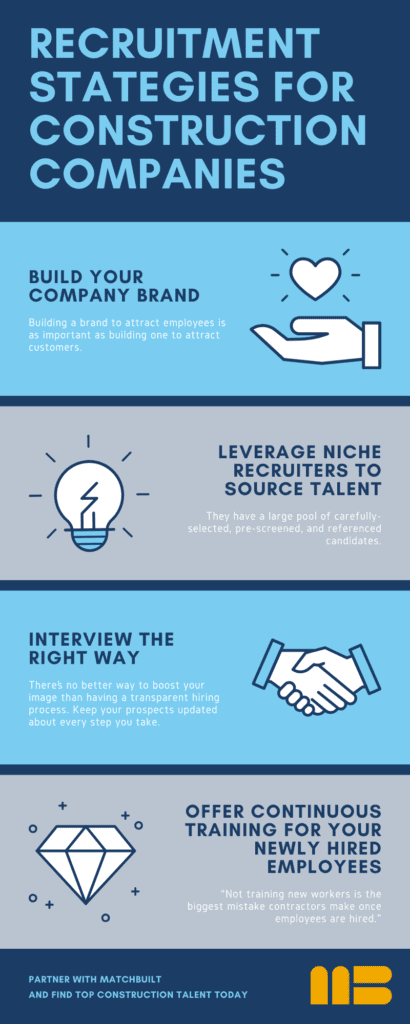Learning how to hire construction workers is critical for any construction company seeking growth. Whether you’re seeking a construction superintendent, project manager, customer service representative, sales personnel, or supply chain professional, it’s important to have a construction recruiting strategy that’s effective and budget friendly.
Further, construction companies hiring in the current market face increased competition, higher wages, and a weaker talent pool because the pandemic exasperated an already significant shortage of skilled construction workers at nearly all levels.
With this in mind, we’ve crafted this guide on the best recruitment strategies for construction companies, and we’ll take a step-by-step look at how you can put the odds in your favor.
Here’s a high-level overview of what you’ll learn:
How to hire construction workers?
To hire construction workers, you’ll need to build your company brand, leverage niche recruiters, interview the right way, and offer continuous training.
Best Recruitment Strategies for Construction Companies
The top recruitment strategies for construction recruiting include but are not limited to building a great company brand that candidates are attracted to, sourcing great talent in new ways, interviewing appropriately, and continuing to train your new hires.
Construction companies’ recruitment strategies have never been more critical. In fact, Brent Darnell International, a company that teaches emotional intelligence in construction, has even said that there’s a “war for talent” now in the construction market.
In addition, the Home Builders Institute suggests that 740,000 new construction workers are needed annually for three years to account for attrition.
The construction industry needs more than 61,000 new hires every month to keep up with both industry growth and the loss of workers either through retirement or simply leaving the sector for good,” said Home Builders Institute CEO Ed Brady. “From 2022 through 2024, this total represents a need for an additional 2.2 million new hires for construction, and that’s a staggering number.
These next four steps will guide you on how to hire construction workers by providing a strategy that’ll work now and in the future.
Step 1: Build Your Brand for Better Communication
Believe it or not, building a brand to attract employees when construction recruiting is as important as building one to attract customers. Think about it; you’re not the only one hiring; you must provide a reason for employees to choose you over others.
Establish Priorities to Show That You Care
Safety is one of the major concerns in the construction industry and one key priority to highlight and provide focus on. Showcasing how you handle your safety measures is a thoughtful gesture and a great way to promote how you care for your employees.
Through your communication channels, talk about your long-term safety record, how you deal with workplace hazards, and how you plan to improve in the future.
Your communication will show that you value your employees’ health and wellbeing.
Embrace a Worker-First Mindset
Before the 2000s, working for long hours in the harshest environments meant having a construction job.
Employees back then didn’t have options, so they were forced to accept. Today, many employers have taken the initiative to improve their workers’ mental health.
Take Shawmut, for example. In 2016, they implemented a flexible work program that yielded many positive results. They offered shift sharing, part-time hours, compressed workweeks, and even telecommuting.
Shawmut Design and Construction has announced the creation and implementation of Shawmut Flex, a program that allows employees the option to flex their time, condense the work week, and telecommute. Recognizing that its people are its greatest asset, Shawmut Flex was designed to improve work-life integration, retain top talent, and recruit the best in the industry.
Implement Technology to Reach a Larger Audience
It’s inevitable that your company will have to hire millennials in the next few years, and Deloitte expects millennials to comprise about 75% of the global workforce by 2025. That said, you need to leverage technology to hire construction workers if you aren’t already. That means marketing on social media, leveraging LinkedIn to its fullest, and using an ATS system to review a high volume of resumes.
Brad Humphry, the founder of Pinnacle Development Group, a consulting firm that has built a reputation as a developer of leaders, a facilitator of strategic growth, and a tailored provider of professional resources, mentioned this about millennials.
I don’t think Millennials look at construction naturally because they are very computer literate and feel more comfortable working with all sorts of electronics.
Further, the Associated General Contractors of America showed that nearly one-fourth of firms report using cutting-edge solutions like robots, drones, 3D printers, and GPS-guided machinery. If you don’t catch up, you’ll soon risk a significant worker shortage.
Build Career Paths to Attract Ambitious Employees
As you learn how to hire construction employees, you may need to remind yourself how much the industry has changed over the last several years. It’s essential to change this idea that all construction workers wear hard hats and that you can’t make much money. If you make it clear that your company provides room for growth, you will attract employees who are ready to be devoted and loyal.
Featuring career paths is especially important for the construction industry regarding student vacancies. Make sure to outline the career goals you offer, then illustrate the training or education needed to reach those goals.
Tyson Conrad, the CEO of Goliath Construction Consulting, suggests the following.
For so long, it was assumed that if you worked with a hard hat, you didn’t make a lot of money, and you were a dummy.
This said, consider going the extra mile by actually supporting your current construction employees with a clear growth path, providing tuition reimbursement, and developing mentoring opportunities for future leaders.
Embrace Your Current Workforce to Avoid Losing Them
It’s obvious that your construction company should retain its employees rather than have a high turnover. It’s more economical since you won’t need to allocate an additional budget for hiring campaigns. It also decreases the likelihood of surprising worker shortages.
If you have unhappy employees, something is wrong with your environment, your compensation, philosophy, etc. Even the best construction hiring strategies can’t fix a broken culture or work environment. In fact, we can tell you how to recruit, but we can’t tell you how to please your current employees. You’d have to analyze your shortcomings to be able to improve them.
What is the best way to find what upsets your workers? Ask them!
A study made in 2017 reinforced this and showed that only 39% of construction companies measure their employee engagement, and even more surprising is that only 21% of the workers are motivated by their bosses!
Allocate Signing Bonuses to Encourage More Applicants
If your budget allows it, allocate signing bonuses to encourage more people to consider your company. However, making them conditional on a minimum employment term is essential; otherwise, people may leave their jobs as soon as they get their bonuses.
Here are a couple of reasons to allocate a signing bonus when putting together your construction recruiting strategy:
- To stay competitive: A signing bonus is more likely when a construction company competes with other employers for the same worker. It’s also a clear sign that a construction employer is really interested in a candidate.
- To maintain internal salary equity: Sometimes, especially at large construction companies, a candidate will ask for a higher salary (learn how much construction workers make here), only to be told it’s outside the company’s salary range for their level. There might be much less flexibility in terms of salary, and in that case, the company might make up the difference—for the first year—with a signing bonus.
- To make up for benefits left behind: If a construction employer recruits an experienced worker who will lose out on a bonus or other benefits by leaving their job, the employer may use a signing bonus to make up the difference.
Spice Up your Offers with Benefits Packages
If you’re low on budget and can’t afford raises or bonuses as part of your construction industry recruitment strategy, you might consider arranging a benefits package.
A workforce report made in 2016 found that 60% of employees consider a benefits package offering crucial for their job satisfaction. In a basic benefits plan, construction employees look for, and employers typically provide health insurance, employer-matching retirement plans, and additional insurance (life and disability) coverages.
Build an Effective Company Careers Page
Imagine that you’ve done an impressive digital campaign to ratchet up your construction recruitment to the next level. You’ve prepared ads, sent emails, and even encouraged your employees to share vacancies on their social media. Traffic to your job posting at picking up!
Now all that’s left is to capture prospects’ interest with an effective careers page on your company website. Here’s how to take your construction company career page to the next level:
Write a Compelling Mission Statement
Let’s face it. Nobody likes a mission statement that sounds bland, and don’t flood it with jargon to make your company look professional.
Instead, write about your culture, what you want in an employee, and why working with your construction company is unique and worth it.
Oh, and don’t call it “mission statement.” Find a title that goes along with your values and mission.
Add Testimonials to Show Credibility
Please don’t claim that you have the best work environment; let your employees say it on your behalf. Including testimonials on your careers page will make your construction company sincere and credible.
Say No to Stock Photos
A picture is worth a thousand words. Well, stock photos are worth nothing!
Add photos of your offices, employees in action, worksites, etc. Include your branded shirts, banners, and logo in these photos.
Marianne Monte, the CPO of Shawmut, says it perfectly.
Photos of employees working outside feeling the sunshine and breathing fresh air could be enticing to many millennial job seekers, particularly when compared to being stuck in an office cubicle.”
Step 2: Source the Best Qualified Employees
After establishing your brand in your quest to learn how to hire a construction worker, you’re ready to start the actual search for employees.
Use Job Boards for Basic Prospects
Some people claim that job boards will become obsolete as social media grows more and more, and nobody knows what could happen. Still, job boards hold a significant share in today’s hiring market and play a critical role as you learn how to hire construction workers.
Niche job boards for construction workers are usually less popular than general ones, which is why they have less traffic. However, their leads are better targeted with a higher chance of success. It wouldn’t hurt to post on free boards, for sure.
Consider Construction Recruitment Firms to Source Confidential Passive Candidates
The biggest problem with job boards is the lack of filtering. You can get hundreds of applications but find out that only 20% have the right skills. This isn’t the case with a construction recruitment firm as they have a large pool of carefully-selected, pre-screened, and referenced candidates. This way, your prospects will have a higher chance of being a better fit.
Furthermore, recruiting firms provide you with unique insights into your local community and specific industry. You’ll know about the salary rates, career expectations, available skill sets, various hiring complexities, and much more data that you couldn’t find elsewhere.
Work on the Word of Mouth
A LinkedIn study in 2015 revealed that 92% of consumers trust their peers over brands when they consider purchasing, and recruiting is no different.
Keep your current employees posted about your vacancies and share them on their social media. You can also assign bonuses to reward qualified leads that get hired.
Reach Out To Students
Giving presentations at your local high schools or universities is a sure way to spread the word about your company and should be integral to your construction industry recruitment strategy.
Consider offering summer jobs, internships, or apprenticeships to engage students and give them a general sense of the construction industry. Even if you don’t hire them, you’ll be the first company they consider when they’re old enough.
Further, consider collaborating with local programs that train students. Take YouthBuild, for example, a program that teaches construction skills to youth, enabling them to build affordable housing for themselves and their community.
YouthBuild champions today’s opportunity youth who aspire to improve their lives and communities by building the skills and resources to reach their full potential. Through hundreds of YouthBuild programs in the United States and around the globe, these young people pursue their education, prepare for future careers, and grow into community leaders – building brighter futures for themselves and their neighborhoods.
Follow Up With Prospects, or Be Forgotten!
It usually takes more than one email to close hires, similar to marketing and sales. The conversion rate goes up with every step you take.
However, don’t go shooting emails like you have nothing else to do! Leave four days, at least, before sending a follow-up email.
It’s important to stay pure to have a higher chance of grabbing the attention of your prospects. Try something along the lines of:
- Had the opportunity to check our offer yet?
- This offer didn’t go to spam, did it?
- Hey, have you seen this offer before?
Step 3: Crown Your Efforts By Interviewing the Right Way
You’ve built your brand and sourced high-quality prospects. Now it’s time for the big day, the interviews.
Keep Them Simple
A shocking survey in 2013 found that 92% of American employees were stressed by at least one thing about the interview process. It certainly doesn’t have to be like this! A competent employee could slip through your fingers just because he was stressed on this day.
First things first, start your interview on time. This way, your candidates won’t be stressed by waiting and overthinking about what will happen.
Take time to introduce yourself, your co-workers, and your company. This will make it easier for candidates to loosen up and be comfortable.
Try to avoid yes/no questions. Instead, ask open questions with “what,” “why,” and “how” to keep the conversation going. Using an evidence-based recruiting process is a preferred method by leading construction companies.
Stay Transparent for Your Benefit
There’s no better way to boost your image than having a transparent hiring process. Keep your prospects updated about every step you take.
You can even apply this early on in the job ad. State a rough estimate about when you’d reply to each application.
Then, craft a hiring process checklist and email your prospects after each item is passed or failed.
Sharing your process with candidates will allow those you didn’t hire to rethink their situation and take action accordingly. You never know, maybe these failed candidates would be suitable for employment in the future.
Post-Interview Surveys to Improve the Process
You won’t hire everyone you interview, that’s for sure. But you can still benefit from those who didn’t make it.
Follow up on your interviews with a phone survey. Ask them about how their interview went, what they liked, and what could’ve been better. The survey results will give you a better understanding of your prospects.
As an HR professional or business owner, you may be interested in our recent post on how to improve the candidate experience.
Step 4: Offer Continuous Training for Your Newly Hired Employees
Most construction companies are doers rather than trainers. They tend to place new employees inside a crew and tell them to watch and try to keep up. On the other hand, proper training should be structured and systematic.
Nearly all employees have low productivity in the first two weeks anyways, so you might as well harness this period to your benefit.
Gilbane is one of the most notable companies in this field. They developed their internal educational platform under “Gilbane University” and earned a ranking of #25 in the list of the top training organizations made by Training magazine.
Gilbane University is our flagship internal training and talent development organization. Building better builders is our goal, and we take an end to end, long term view of our employees’ career paths to ensure they can reach their full potential, for their benefit as well as that of our clients. Classes cover a wide range of methods, including virtual lessons, in person conferences, videos, and VR courses targeted toward all roles within the company.
Make Hiring Women Employees a Priority in Your Construction Recruitment Strategy
The construction industry has been nearly void of women workers for the past decades, and women account for only 10% of construction managers in the US.
A study done in 2015 found that companies choosing to diversify on gender are 15% more likely to generate profit. Remember, you have to build an inclusive workplace culture to recruit and retain women workers. In 2017, Iron Workers Union was the first to grant six months of fully paid maternity leave.
You can go the extra mile by offering childcare, childcare subsidies, or extending the length of the maternity leave. Every step you take will make your employees more loyal. You can also make women-focused apprenticeships in your local schools and universities. You’ll guarantee a future stream of high-end workers to fill your potential vacancies.
More About Millennials in Construction
Millennials differ a lot from older workers. For instance, 86% of millennial employees said they’re willing to work for a company with an exciting mission and vision, even if they earned less. On the other hand, only 9% of workers older than 50 agreed.
Moreover, a survey done in 2016 showed that minorities comprise about 50% of the millennials in 10 states, like Georgia, Florida, Arizona, Texas, and New Jersey. The study shows the importance of boosting the inclusive atmosphere of your work environment.
Construction Recruitment Strategies Infographic
We hope these construction company recruitment strategies have helped you better understand the market. Investing time and money to improve your process today will guarantee a better and broader future pipeline. Ready for the next step? We can help you reach the top candidates in the construction industry. Visit the “partner with us” page if you want more information.
Looking for Construction Companies Hiring?
Construction Management JumpStart: The Best First Step to a Career in Construction
From the author:
Launch your career in construction management with this one-of-a-kind book
The construction management industry will increase employment by 16 percent over the next decade. This second edition of a bestselling introduction to construction management walks you through each stage of the construction management process.
This book will familiarize you with all the construction management fundamentals and how Building Information Modeling (BIM) impacts the construction management profession.
- Covers interoperability of technology advances in the construction industry
- Explains how BIM is challenging the traditional approach to project delivery and how this affects the constructor’s role
- Elaborates on each stage of the design and construction process and the tasks associated with each of them
- Shows step-by-step how to estimate project costs, administer contracts, manage job site and construction operations, plan and schedule a project, monitor project performance, manage project quality and safety, and assess project risks
- Provides review questions at the end of each chapter to help enforce understanding
The tried-and-true project management principles presented in this book will help ensure a successful start to your career.




